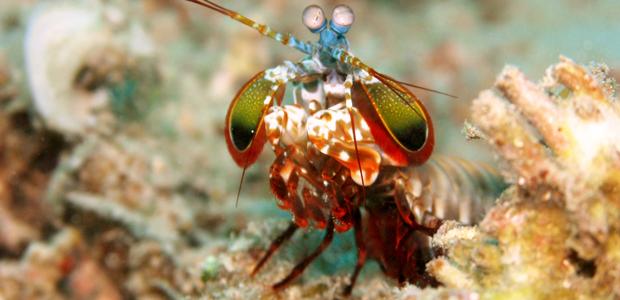A team of researchers from the United States and Singapore have analyzed the indo-pacific crustacean’s hammer-like club, to figure out what allows them to deliver such devastating blows without suffering catastrophic consequences.
It’s not a peacock, mantis or shrimp, but the peacock mantis shrimp – also known as Odontodactylus scyllarus – can deliver a mighty wallop that travels at a speed equivalent to a 0.22-caliber bullet, alongside a force that’s equally staggering.
Now, a team of researchers from the United States and Singapore have analyzed the indo-pacific crustacean’s hammer-like club, to figure out what allows them to deliver such devastating blows without suffering catastrophic consequences.
“This club isn’t just one uniform, composite material,” David Kisailus, study co-author and materials scientist at the University of California Riverside, told Science-Fare.com. “It actually consists of three separate regions that together make the club stiff and also fracture tough, which are two inversely related properties.”
It’s probably no shock that the chitinous, impact surface of their club is about five times thicker than the rest of the appendage – they’re like built-in seafood crackers that work by punch.
But, when the researchers used x-ray diffraction to analyze the components that make up the impact surface, they found the mineral hydroxyapatite – the calcium compound that makes up bone.
“Hydroxyapatite, which is made at room temperature, has a compressive strength in this club that’s four gigapascals,”Kisailus said. More importantly, the mineral is packed into the club so efficiently that its compressive strength is twice that of zirconia – the engineered diamond that takes temperatures higher than 1,000 C to manufacture.
When they looked at the periodic region of the club that supports the impact surface, the researchers found the minerals were amorphous – they weren’t arranged so efficiently – allowing them to absorb the shockwave generated each time the stomatopod connects a punch.
“Counter intuitively, nature has designed things to fail, but fail at small scales – on the nanoscale – rather than catastrophically,” Kisailus said. “It will actually introduce cracking, but these cracks can’t travel far and it will just basically absorb a lot of energy.”
Under an electron microscope, they found that each chitin layer was rotated just enough to give the entire region a helix shape, like our DNA – with the spaces filled in with the amorphous minerals.
This spiral shape helps to absorb the shocks and provides a nanoscale track for them to travel on if they develop – because these creatures molt, the area just needs to sustain the damage until the new exoskeleton develops.
“Because the fibres are arranged in this helicoidal architecture, those cracks will have to propagate a very long distance to escape the club – and they never do,” Kisailus said. “They essentially run out of steam before they can propagate through the entire club.”
Finally, they found the entire club is wrapped in chitin much like a boxer tapes their wrists.
“These chitin fibres essentially place the club under compression,” Kisailus said. The striated region also helps redirect the shockwaves toward the periodic region where they can be absorbed.
Together, it’s these three regions that allow the four-inch long stomatopod to deliver a blow with 200 lb. of force that candidly, Kisailus says, “hurts like hell”.
With this structural information, Kisailus has already started mimicking the design using fibre and epoxy composite materials.
Just a couple centimetres thick, the preliminary designs indicate that with some refining, this could lead to the creation of lighter, but stronger armour – along with a ton of other potential applications.
“We’ve taken them out to the desert and tried to shoot them with different munitions, including high velocity rounds,” Kisailus said. “Interestingly, our composite materials completely stopped these rounds.”
“It’s interesting how the organisms that researchers have studied over the past decades for impact tolerance, snails and crab exoskeletons, become the dinner of the stomatopods and I think that’s pretty telling,” he added.
The research was published in the journal, Science.
 Science Fare Media Science News – Upgraded
Science Fare Media Science News – Upgraded


